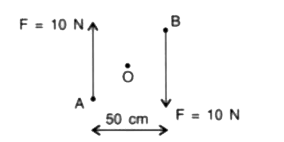Two forces, while acting on particle in opposite directions,have the resultant of 10N. If they act at right angles to each other, the resultant is found to be 50N. Find the two forces?
The correct Answer is:40 N & 30 N
Let the magnituds of forces be A and B.
then according to question A−B=10
⇒A=10+B.................(1)
and √A2+B2=50
⇒A2+B2=2500.............(2)
Solving equation number (1) & (2)
A= 40 N and B = 30N
Therefore the magnitudes of forces are 40 N & 30 N
Topper's Solved these Questions
- BASIC MATHEMATICS USED IN PHYSICS &VECTORS BOOK - ALLENCHAPTER - BASIC MATHEMATICS USED IN PHYSICS &VECTORS EXERCISE - BEGINNER S BOX 10
3 Videos
- BASIC MATHEMATICS USED IN PHYSICS &VECTORS BOOK - ALLENCHAPTER - BASIC MATHEMATICS USED IN PHYSICS &VECTORS EXERCISE - BEGINNER S BOX 11
5 Videos
- BASIC MATHEMATICS USED IN PHYSICS &VECTORS BOOK - ALLENCHAPTER - BASIC MATHEMATICS USED IN PHYSICS &VECTORS EXERCISE - BEGINNER S BOX 8
2 Videos
- CENTRE OF MASSBOOK - ALLENCHAPTER - CENTRE OF MASSEXERCISE - EXERCISE-V B
19 Videos
Similar Questions
Two forces of 45 kg-f and 40 kg-f act on a body In opposite directions. What Is the resultant force ?
View SolutionThe resultant of two forces at right angles is 13N. The minimum resultant of the two forces is 7 N. The forces are
View SolutionA body is acted upon by two forces each of magnitude F, but in opposite directions. State the effect of the forces if
(a) both forces act at the same point of the body.
(b) the two forces act at two different points of the body at a separation?
View SolutionFig.1.31 shows two forces each of magnitude 10N acting at points A and B at a separation of 50cm, in opposite directions. Calculate the resultant moment of the two forces about the point (i) A (ii) B and (iii) O situtated exactly at the middle of the two forces.

View SolutionTwo forces act at a point and are such that if the direction of one is reversed, the resultant is turned through a right angle. Show that the two forces must be equal in magnitude.
View SolutionTwo forces whose magnitudes are in the ratio 3:5 give a resultant of 28N. If the angle of their inclination is 60∘, find the magnitude of each force.
View SolutionTwo forces whose magnitudes are in the ratio 3:5 give a resultant of 28N. If the angle of their inclination is 60∘, find the magnitude of each force.
View SolutionTwelve forces each of 5 N act on a body simultaneously. If each force makes an angle of 30° with other their resultant is
View SolutionThe sum of the magnitudes of two forces acting at a point is 18 and the magnitude of their resultant is 12. If the resultant is at 90∘ with the force of smaller magnitude, What are the magnitudes of forces?
View SolutionThe sum of the magnitudes of two forces acting at a point is 18 and the magnitude of their resultant is 12. If the resultant is at 90∘ with the force of smaller magnitude, What are the magnitudes of forces?
View Solution
